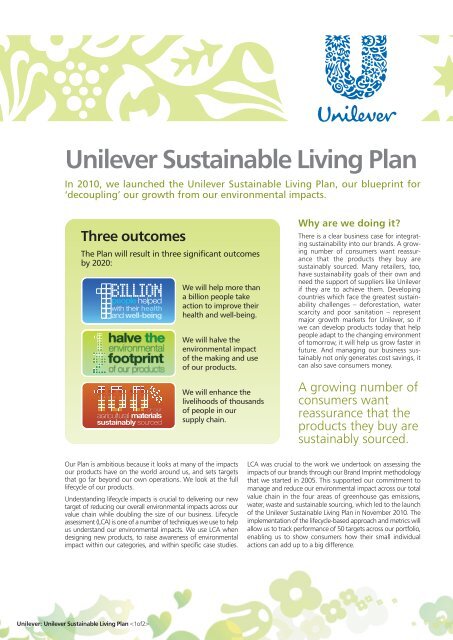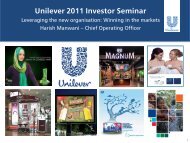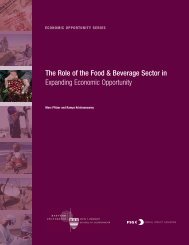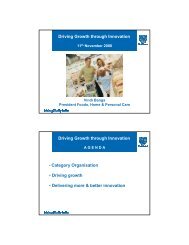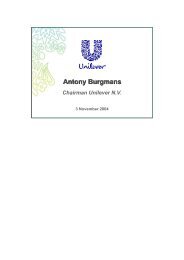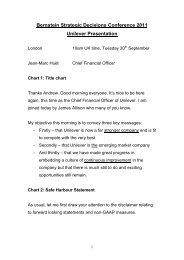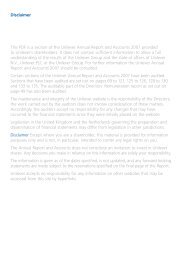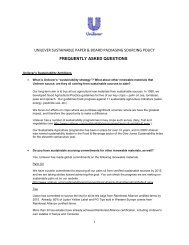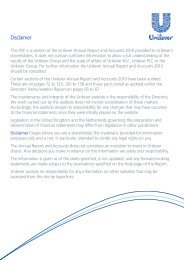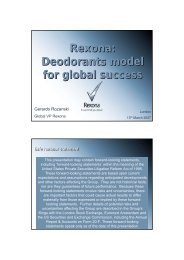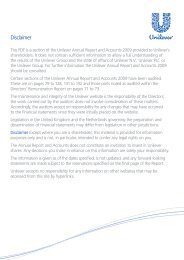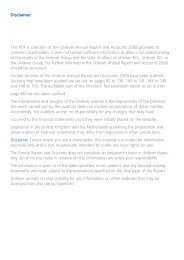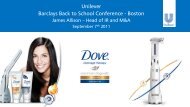Sustainable living facts - Unilever
Sustainable living facts - Unilever
Sustainable living facts - Unilever
Create successful ePaper yourself
Turn your PDF publications into a flip-book with our unique Google optimized e-Paper software.
<strong>Unilever</strong> <strong>Sustainable</strong> Living Plan<br />
In 2010, we launched the <strong>Unilever</strong> <strong>Sustainable</strong> Living Plan, our blueprint for<br />
‘decoupling’ our growth from our environmental impacts.<br />
Three outcomes<br />
The Plan will result in three significant outcomes<br />
by 2020:<br />
<strong>Unilever</strong>: <strong>Unilever</strong> <strong>Sustainable</strong> Living Plan <br />
We will help more than<br />
a billion people take<br />
action to improve their<br />
health and well-being.<br />
We will halve the<br />
environmental impact<br />
of the making and use<br />
of our products.<br />
We will enhance the<br />
livelihoods of thousands<br />
of people in our<br />
supply chain.<br />
Our Plan is ambitious because it looks at many of the impacts<br />
our products have on the world around us, and sets targets<br />
that go far beyond our own operations. We look at the full<br />
lifecycle of our products.<br />
Understanding lifecycle impacts is crucial to delivering our new<br />
target of reducing our overall environmental impacts across our<br />
value chain while doubling the size of our business. Lifecycle<br />
assessment (LCA) is one of a number of techniques we use to help<br />
us understand our environmental impacts. We use LCA when<br />
designing new products, to raise awareness of environmental<br />
impact within our categories, and within specific case studies.<br />
Why are we doing it?<br />
There is a clear business case for integrating<br />
sustainability into our brands. A growing<br />
number of consumers want reassurance<br />
that the products they buy are<br />
sustainably sourced. Many retailers, too,<br />
have sustainability goals of their own and<br />
need the support of suppliers like <strong>Unilever</strong><br />
if they are to achieve them. Developing<br />
countries which face the greatest sustainability<br />
challenges – deforestation, water<br />
scarcity and poor sanitation – represent<br />
major growth markets for <strong>Unilever</strong>, so if<br />
we can develop products today that help<br />
people adapt to the changing environment<br />
of tomorrow, it will help us grow faster in<br />
future. And managing our business sustainably<br />
not only generates cost savings, it<br />
can also save consumers money.<br />
A growing number of<br />
consumers want<br />
reassurance that the<br />
products they buy are<br />
sustainably sourced.<br />
LCA was crucial to the work we undertook on assessing the<br />
impacts of our brands through our Brand Imprint methodology<br />
that we started in 2005. This supported our commitment to<br />
manage and reduce our environmental impact across our total<br />
value chain in the four areas of greenhouse gas emissions,<br />
water, waste and sustainable sourcing, which led to the launch<br />
of the <strong>Unilever</strong> <strong>Sustainable</strong> Living Plan in November 2010. The<br />
implementation of the lifecycle-based approach and metrics will<br />
allow us to track performance of 50 targets across our portfolio,<br />
enabling us to show consumers how their small individual<br />
actions can add up to a big difference.
Sustainability goals<br />
We have set ourselves ambitious targets in our <strong>Sustainable</strong> Living Plan:<br />
Health and<br />
hygiene<br />
By 2020, we will help more than a billion<br />
people to improve their hygiene<br />
habits and we will bring safe drinking<br />
water to 500 million people.<br />
Nutrition<br />
By 2020 we will double the proportion<br />
of our portfolio that meets the highest<br />
nutritional standards, based on globally<br />
recognised dietary guidelines. This will<br />
help hundreds of millions of people to<br />
achieve a healthier diet.<br />
Greenhouse gases<br />
By 2020 we aim to halve the greenhouse<br />
gas impact of our products<br />
across the lifecycle – from the sourcing<br />
of raw materials, through to consumer<br />
use and disposal.<br />
<strong>Unilever</strong>: <strong>Unilever</strong> <strong>Sustainable</strong> Living Plan <br />
Water<br />
We aim to halve the water associated<br />
with the consumer use of our products<br />
by 2020. We will focus our efforts in<br />
countries that are populous and waterscarce<br />
– countries where much of<br />
<strong>Unilever</strong>’s growth is expected to happen.<br />
Waste<br />
• By 2020 we will help more than 1 billion<br />
people to improve their hygiene habits<br />
and we will bring safe drinking water to 500<br />
million people<br />
• If we used concentrated variants we would<br />
save over 4 million tonnes of CO2 per<br />
year, equivalent to taking 1 million cars off<br />
the road annually<br />
• More than 500 billion litres of water would<br />
be saved if all our laundry product users in Asia<br />
and South Africa used Comfort One Rinse<br />
• Our registered Suave shampoo bottle saved<br />
the equivalent of more than 100 million<br />
plastic bottles over four years<br />
From the factory floor to the shop shelf,<br />
we will reduce, reuse, recycle and eliminate<br />
packaging materials from the lifecycles<br />
of our products. We aim to halve<br />
the waste associated with the disposal<br />
of our products by 2020.<br />
<strong>Sustainable</strong> sourcing<br />
Food security is under threat from rising<br />
populations, changing weather patterns,<br />
water scarcity and unsustainable<br />
farming practices. Half our raw materi-<br />
See the <strong>Unilever</strong> <strong>Sustainable</strong> Living Plan at:<br />
www.sustainable-<strong>living</strong>.unilever.com/<br />
als come from farms and forests. By<br />
2020 we will source 100% of our agricultural<br />
raw materials sustainably.<br />
Better livelihoods<br />
We work with hundreds of thousands of<br />
smallholder farmers, small-scale distributors<br />
and micro-entrepreneurs, many of<br />
whom are in the developing world. We<br />
help them to improve their skills and increase<br />
productivity so that they can increase<br />
their income and standard of <strong>living</strong>.<br />
Our goal is to link 500,000 smallholder<br />
farmers into our supply network. We<br />
will help to improve their agricultural<br />
practices and thus enable them to supply<br />
into global markets at competitive<br />
prices.<br />
We will also increase the number of<br />
Shakti entrepreneurs – door-to-door<br />
sales operators in rural India – that we<br />
recruit, train and employ from 45,000<br />
in 2010 to 75,000 in 2015.<br />
• The upside-down deodorant pack for Rexona,<br />
Sure and Dove uses up to 18% less<br />
plastic in each pack<br />
• All Lipton Yellow Label and PG Tips tea bags<br />
in Western Europe were sourced from<br />
Rainforest Alliance Certified farms<br />
by 2010<br />
- Covering 70 tea estates and 38,000<br />
smallholder farmers<br />
- Providing good working conditions for<br />
175,000 tea growers and conserving<br />
water supplies and protecting wildlife


